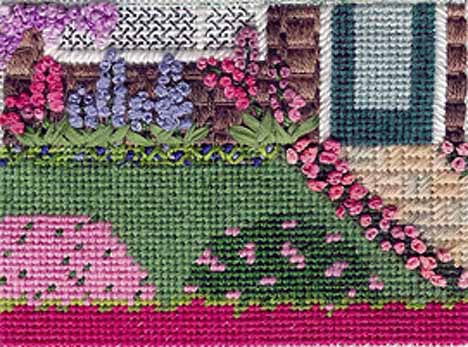
Updated January 11, 2019.
Texture is an important part of most kinds of art. There are two main types of texture. Tactile texture is one that you can feel. For us that would be the texture of a thread. Visual texture is one that you see instead of feel.
Needlepoint is unusual because it has both kinds of texture present. Because of this texture plays an important part in all our needlepoint.
Understanding texture and how to use it can easily elevate your needlepoint from blah to ahhh.
Understand the ranking of texture in both stitches and threads. Texture is threads is always a range. Threads can range from smooth to rough (rough has more texture), from dull to shiny (shiny has more texture), flat to furry (furry has more texture). The thread with more texture is almost always the one your eye will look at first. Use this when placing threads.
Texture in stitches ranges from high (turkeywork) to low (pattern darning), from large (Scotch) to small (tent), from open to filled. Stitches that are bigger, higher (layered counts too)have more texture.
Stitches and threads with higher texture should go in areas you want people to notice. For example, don’t do a shiny metallic background; it will overwhelm the focal point. I know I did this once and ruined a piece.
When stitching realistic items, use the texture of the item in real life as a starting point. I think of Fuzzy Stuff when I think of this. Fuzzy Stuff is a great thread; it creates a marvelous furry texture. You’d think that would make it perfect for fur. But there’s one big problem, in the thread there is a bit of sparkle. To my eye, this, turns the animal into a stuffed animal in most cases. I get a disconnect when I use it. Be cautious when picking thread textures so there isn’t a disconnect.
Some thread textures mask stitch textures. Ideally the two should be in balance. but some threads have textures that make the stitches indistinguishable. Very Velvet is a perfect example of this. Use this thread in Tent and it looks like velvet fabric. Use it in a stitch with strong lines, such as Scotch, and you’ll see solid motifs. But use it in a stitch without these lines, such as Nobuko, and much of the beauty of this thread is lost. Use a dark color and you probably wasted your time. If the texture of the thread masks the texture of the stitch, rip it out and start over.
About Janet M Perry
Janet Perry is the Internet's leading authority on needlepoint. She designs, teaches and writes, getting raves from her fans for her innovative techniques, extensive knowledge and generous teaching style. A leading writer of stitch guides, she blogs here and lives on an island in the northeast corner of the SF Bay with her family

Leave a Reply